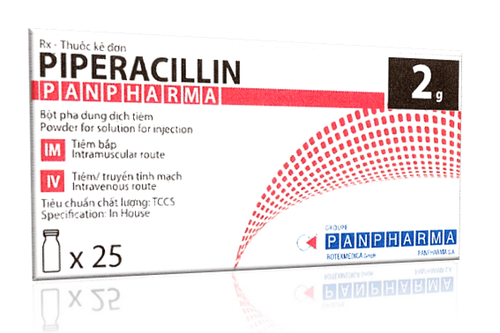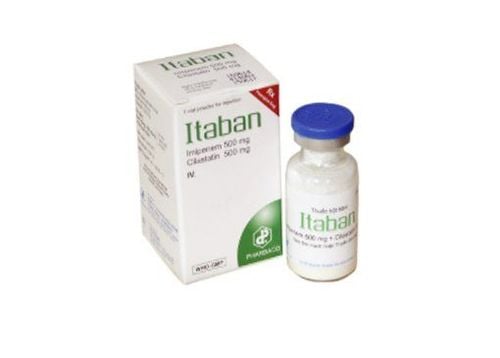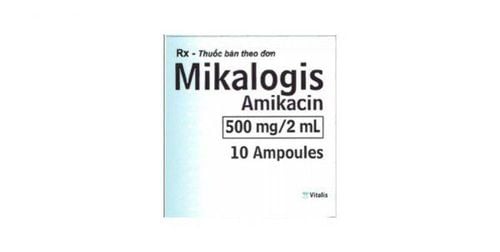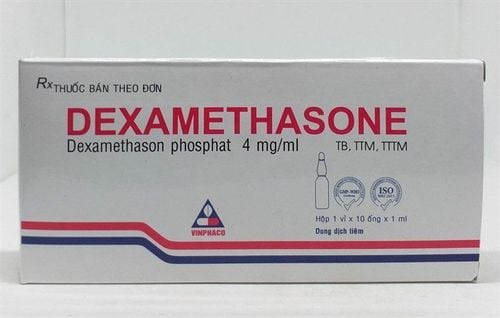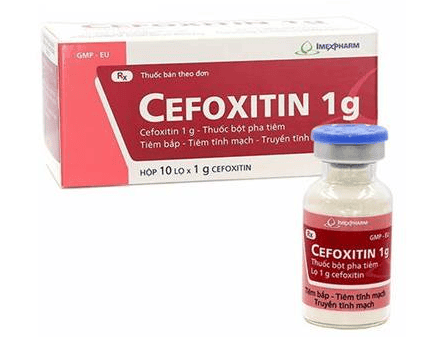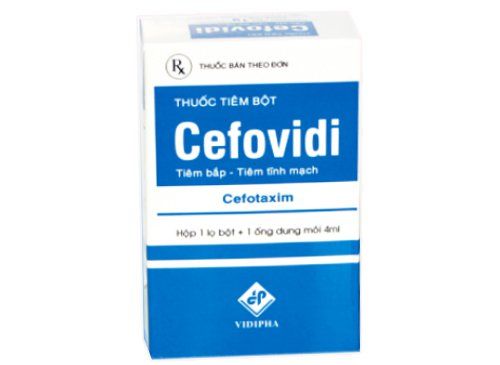This is an automatically translated article.
Artamciclin drug has the main ingredients Piperacillin sodium, Tazobactam sodium along with other excipients. Artamciclin is used in the treatment of systemic infections, lower respiratory tract infections, intra-abdominal infections, sepsis,... Let's find out more details about how to use and note when treating with Artamciclin. through the article below.
1. What is Artamciclin?
Artamciclin drug belongs to the group of drugs that treat parasites, anti-infectives, antivirals, antifungals. Artamciclin medicine has the main ingredients Piperacillin sodium 4.0 and Tazobactam sodium along with other excipients.
Artamciclin is prepared in the form of a powder for injection packed in a box of 1 vial. The drug is researched and manufactured at the Instituto Biologico Contemporaneo S.A - HEN TI NA.
2. What are the uses of Artamciclin?
Artamciclin is used in the following cases:
Treatment of systemic or local infections confirmed or suspected due to susceptible organisms Lower respiratory tract infections Complicated urinary tract infections Focal infections Abdominal soft tissue skin infections Sepsis Obstetrics and gynecological infections Polymicrobial infections. Piperacillin and Tazobactam in the drug have synergistic effects with aminoglycosides against some strains of Pseudomonas aeruginosa. Combination therapy has been successful, especially in immunocompromised patients. As soon as antibiogram results are available, antibiotic therapy should be adjusted.
3. Dosage - How to use Artamciclin effectively
3.1. Dosage Dosage is calculated according to the equivalent amount of piperacillin and must be reduced in the presence of renal failure. Artamciclin can be injected deep intramuscularly or slowly intravenously for 3 - 5 minutes or intravenous infusion for 20 - 40 minutes. Artamciclin should not be injected intramuscularly more than 2g (for adults) or more than 0.5g (for children).
Intravenous injection: Each vial of Artamciclin 4.5g is mixed with 20ml of sterile distilled water or 0.9% NaCl by slow intravenous injection over 3-5 minutes. Intravenous infusion: Each 4.5g vial of Artamciclin is mixed with 20ml of sterile distilled water or 0.9% NaCl, then diluted further to at least 50ml intravenously over 20-30 minutes. 3.2. Dosage Reference Artamciclin dosage is as follows:
Adults and children over 12 years: The recommended dose is 4g piperacillin/0.5g tazobactam intravenously every 8 hours. The total daily dose of Artamciclin may vary from 2.25 g to 4.5 g every 6 to 8 hours. Children under 12 years of age: There are no data on the safety and efficacy of Artamciclin in children under 12 years of age. Renal impairment: Piperacillin/Tazobactam dose must be adjusted according to creatinine clearance: Creatinine 20-80 ml/min dose 12 g/1.5 g/day divided into 4 g/500 mg/ 8 hours. Creatinine <20 ml/min dose 8 g/1 g/day divided into 4 g/500 mg/12 hours. In case the patient is on hemodialysis, the maximum total daily dose of Artamciclin is 8 g Piperacillin/ 1g Tazobactam. In addition, because a 4-hour dialysis cycle can remove 30-50% of piperacillin, an additional 2 g of Piperacillin/250 mg of Tazobactam should be injected after each dialysis cycle. The duration of Piperacillin/Tazobactam treatment in case of acute infection must be continued for at least 48 hours after the patient's fever is gone or clinical symptoms have resolved.
3.3. What to do in case of an overdose of Artamciclin? Currently, there is no specific drug for overdose Artamciclin, however, in the event of an overdose with emergency manifestations, all additional medical measures are indicated in the same way as for piperacillin overdose. Use of dialysis to remove excessively high concentrations of piperacillin in serum may be used.
However, in patients using piperacillin at doses of 24 g/day or more, no adverse effects were observed. In case the patient develops convulsions or has motor agitation, anticonvulsants (diazepam, barbiturates) may be indicated. In case of severe illness and anaphylaxis, the patient should immediately begin treatment measures.
In addition, if persistent and severe diarrhea is encountered, the possibility of pseudomembranous colitis should be considered. Therefore, Artamciclin should be discontinued in such cases and appropriate therapy initiated. Absolutely do not use drugs that inhibit intestinal motility in this case.
4. Contraindications to the use of Artamciclin
Artamciclin should not be used in patients with a history of allergy to piperacillin and cephalosporins or to beta-lactamase inhibitors.5. Artamciclin drug interactions
The following are some of the reported Artamciclin drug interactions:
Concomitant administration of piperacillin/tazobactam with probenecid may increase the half-life and clearance of both piperacillin and tazobactam. However, peak plasma concentrations of these components were not affected. No drug interactions were observed between vancomycin and tobramycin and piperacillin/tazobactam. Never mix other drugs when combining piperacillin/tazobactam, do not mix in the same vial or inject at the same time due to physical incompatibility. When Artamciclin is co-administered with high-dose heparin, oral anticoagulants or drugs that affect the coagulation system and platelet function, coagulation parameters should be measured more frequently and carefully monitored. than. To ensure safety when using Artamciclin, patients should inform their doctor about other medical conditions they are experiencing and other drug product lines they are using.
6. Side effects when taking Artamciclin
During the use of Artamciclin, patients may experience some unwanted side effects such as:
Local side effects: Phlebitis, thrombophlebitis. Systemic side effects: Diarrhea, rash, erythema, pruritus, vomiting, nausea, allergic reactions, urticaria and superinfection. Rare systemic adverse reactions (0.1%): Skin reactions, eczema, sweating, erythema multiforme, rash, stomatitis, maculopapular rash, constipation, muscle weakness, hallucinations , dry mouth, myalgia, hypotension, superficial phlebitis, fever, flushing, edema, fatigue, inflammation or pain at the injection site due to not mixing Artamciclin as directed. Reported laboratory adverse changes: Transient decrease in white blood cell count, thrombocytopenic purpura, eosinophilia, thrombocytopenia, positive Coombs test, transient elevation of liver enzymes (SGPT, SGOT). , alkaline phosphatase) in serum, hypokalemia, bilirubin. Rare: Increased renal function parameters such as serum creatinine or urea. Patients should inform their doctor of all side effects they experience during treatment with Artamciclin.
7. Pay attention to precautions when using Artamciclin for treatment
Before initiating treatment with Artamciclin, a thorough history of allergy to penicillins, cephalosporins or other allergens should be sought. If the patient develops an allergic reaction while being treated with piperacillin/tazobactam, the drug should be discontinued immediately. Serious hypersensitivity reactions during piperacillin/tazobactam treatment may require management with adrenaline and other emergency measures.
Although the combined use of piperacillin/tazobactam has low toxicity, it is still advisable to periodically check the function of organs such as liver, kidney, blood during long-term drug treatment. Bleeding manifestations have occurred in some patients treated with beta-lactam antibiotics. This hemorrhagic reaction sometimes occurs in association with abnormalities on coagulation tests such as platelet aggregation, clotting time, and prothrombin time and is more common in patients with renal impairment. If bleeding manifestations occur as a result of treatment, Artamciclin should be discontinued and appropriate therapy instituted. It should be noted that the possibility of emergence of resistant strains of bacteria, especially when the treatment with Artamciclin is prolonged and there is an appropriate treatment direction. During treatment, patients may experience neuromuscular agitation or convulsions when used at doses higher than the recommended intravenous dose. Periodic ionography should be performed if the patient has low potassium stores and attention should be paid to the possibility of hypokalemia in patients with very low potassium stores and those receiving cytotoxic therapy or taking diuretics. There are insufficient data on the safety and efficacy of piperacillin/tazobactam during pregnancy and lactation. However, to be safest, it should not be used for this object. Reconstituted medicine according to the instructions, the drug remains stable up to 24 hours after reconstitution if kept in the refrigerator (2-8°C) and stored in an infusion bag or in a syringe. Never mix Piperacillin/tazobactam with other drugs in the same syringe or infusion bottle. Artamciclin is prescribed by a doctor, patients do not self-medicate. Above are all the uses of Artamciclin, patients need to carefully read the instructions and use the drug in accordance with the doctor's advice to get the best results.




